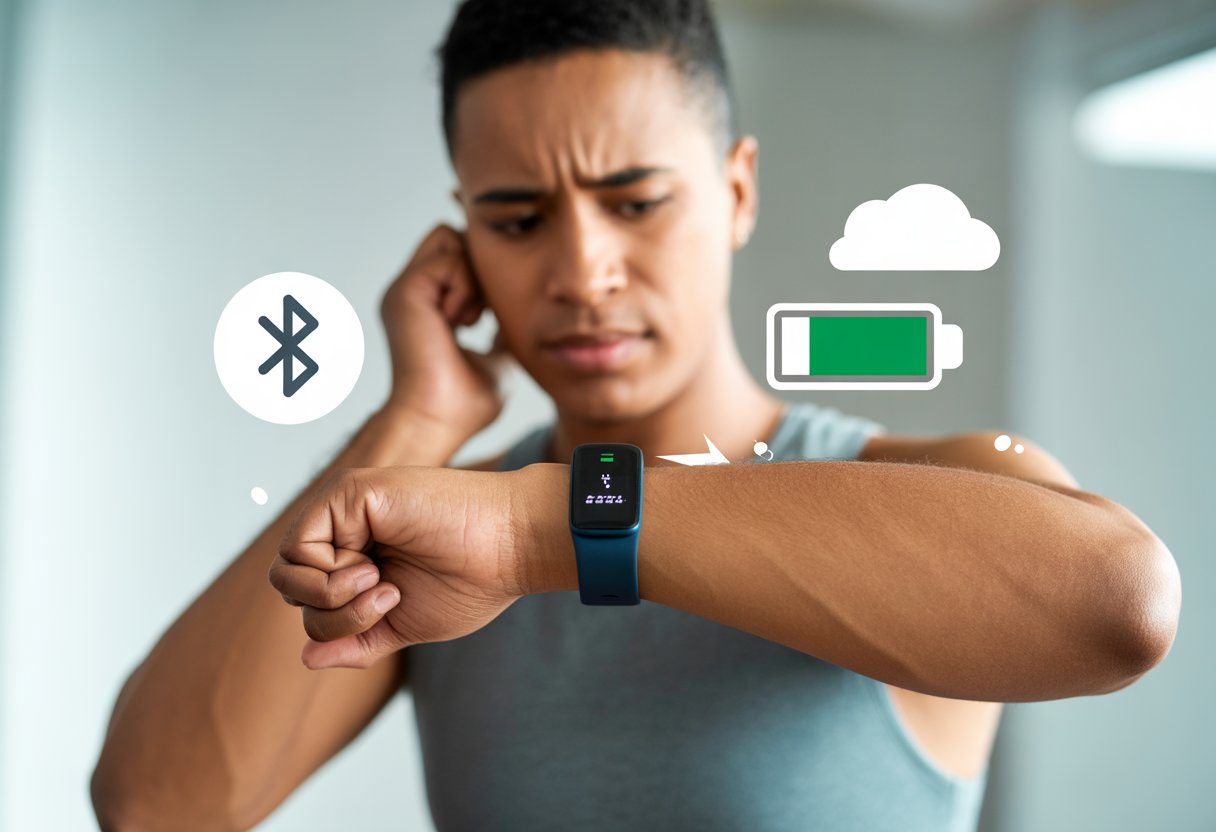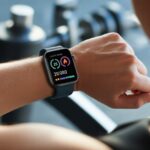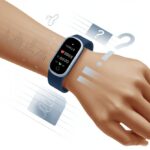We’ve all stared at our fitness trackers, hoping for a satisfying calorie number, only to wonder if it thinks we’re just a couch potato with a pulse. Fitness trackers might not track calories burned correctly if our profile info, device settings, or syncing gets messed up.
Missing data like height or weight throws everything off. Sometimes, a good old restart fixes weird glitches (honestly, turning it off and on again never gets old).

Syncing issues can also trip us up, or maybe our tracker just hates certain activities—especially if we’re more interpretive dance than treadmill sprints. If our gadgets and apps lose their connection, calorie data might disappear, just like when we text ourselves instead of our workout buddy.
Even a dirty sensor or a sneaky privacy setting can ruin everything.
We’re definitely not alone—lots of people have found themselves arguing with their wristbands, hoping to see a higher calorie count. If calories look suspiciously low or vanish, it’s worth checking a few basics: update your info and give your tracker a restart.
For more help, check out why calories aren’t displaying correctly or why calorie tracking might be off in popular apps.
How Fitness Trackers Estimate Calories Burned
We trust fitness trackers to tell us how many calories we’ve burned after a walk—or maybe a sprint to the fridge. But these little wrist computers use more than just step counts to figure out calories.
The Science Behind Calorie Calculation
Fitness trackers use a mix of algorithms and our personal data to make their best guess. Most ask for our age, height, sex, and weight—turns out, our bodies burn energy differently, and the tracker needs all the details it can get.
But here’s the thing: these gadgets don’t measure calories directly. They toss our info into an algorithm and try to estimate our energy use. Each brand uses its own “secret sauce,” so our friend’s tracker might show a totally different number after the same workout.
If we want true accuracy, a metabolic chamber wins every time. That’s the fancy lab room where scientists measure every breath, but let’s be real—we’re not dragging one around on our wrists.
Role of Heart Rate and Activity
Most trackers rely on sensors to monitor our heart rate and movement. The heart rate sensor is crucial—our calorie burn goes up when our hearts pound faster.
So, if we’re huffing up a hill, the tracker notices and adds more calories to our daily total.
Accelerometers—tiny movement detectors—also play a big part. Whether we’re walking, running, or just flailing our arms, these sensors log the action and help estimate calories burned.
But for activities like weightlifting, yoga, or, honestly, just chilling on the couch, the tracker sometimes misses things. That’s why our calorie total can look a little stingy after a tough session.
Factors Influencing Energy Expenditure
Our bodies don’t burn calories the same way, so our numbers might not match someone else’s even if we do the exact same workout. Age, sex, muscle mass, and fitness level all change how we burn energy.
Trackers need our personal info to make a decent guess. If we forget to update our weight or birthdate, the final number gets thrown off.
Even the environment matters—working out in the cold, at high altitudes, or while sick changes our energy use.
Device accuracy is another wild card. Results can swing a lot between brands because each one uses its own algorithm.
Research shows most trackers nail heart rate pretty well, but calorie burn estimates are often way off. We love our trackers, but sometimes they just can’t keep up with our wild energy (or questionable dance moves).
Common Reasons Your Fitness Tracker Is Not Tracking Calories
Sometimes our fitness trackers say we burned zero calories, even after chasing the dog or dancing around the living room. Usually, the real troublemakers are wrong personal info, sensor issues, or old settings we never updated.
Let’s dig into what really throws off our calorie numbers—it might even be something we did ourselves.
Incorrect Personal Information
If we enter the wrong age, weight, height, or gender, our tracker does some wild math. Calories burned depend on these details, and a mistake here leaves us thinking we burned less (or more) than we actually did.
Activity trackers, whether it’s a Fitbit or Apple Watch, need this info to get things right.
Some devices ask for info we haven’t changed in years—who else is still pretending to be 25? And if we switch watches or phones, the info sometimes doesn’t transfer.
Here’s a quick table showing what matters most:
| Info Needed | Impact on Accuracy |
|---|---|
| Age | Changes calorie estimates |
| Weight | Affects how much we burn per activity |
| Height | Alters calculations for steps and stride |
| Gender | Important for metabolic formulas |
If our steps look great but calories seem off, let’s double-check those profile settings.
Sensor Malfunction or Dirty Sensors
Sensors act like our watch’s eyes and ears. If sweat, lotion, or even crumbs block the heart rate sensor, it can’t do its job.
Devices like the Samsung Gear S2 or Basis Peak get especially cranky about dirty sensors. A quick wipe with a clean cloth can save the day.
Sometimes sensors don’t calibrate right or glitch after a swim or a full charge. If our numbers suddenly drop to zero, try a restart or cleaning.
If that fails, the device might need a firmware update—or maybe just a little patience.
Inactive or Incorrect Settings
We’ve all skipped past the settings, but hiding in those menus are options that can turn off calorie tracking. For example, “Workout Power Saving Mode” on Apple Watch can throw off calorie estimates.
Turning off Fitness Tracking or Motion & Fitness permissions does the same thing.
Here are some settings to check:
- Motion & Fitness Tracking: Make sure it’s ON
- Heart Rate Monitor: Needs to be enabled
- Power-saving features: Turn them off during workouts
- App permissions: Check if the fitness app can access health data
If we forget to hit “start workout” or leave battery saver on, don’t expect much from our calorie count.
Even the fanciest trackers—from Fitbit Surge to Mio Alpha 2—can’t read our minds (yet).
Device-Specific Issues and Solutions
Fitness trackers act like moody cats. They work fine—until they don’t, and then we’re left playing detective.
Sometimes it’s just a setting. Other times, a syncing gremlin sneaks in.
And occasionally, we have to go full tech support and try a factory reset.
Fitbit Troubleshooting Steps
Fitbit trackers like the Charge, Surge, or Alta sometimes refuse to count steps or calories. If calories burned look wrong, we should check our user profile—age, weight, height, and gender all need to be right.
Without this, Fitbit can’t do the math any better than we can after a tough workout.
We should also check our heart rate graphs. If they look flat or choppy, the calorie counts will be off.
If the tracker lags or forgets to track, a restart or even a factory reset can help. Unpairing and repairing with the app sometimes fixes things—like magic, or just like rebooting the Wi-Fi at work.
Software updates can fix old bugs, so don’t put them off. They might be the secret to getting our Fitbit, Fitbit Surge, or Samsung Gear S2 back on track.
You’ll find more help in the Fitbit support forums for low-calorie burn issues.
Apple Watch Calorie Issues
Apple Watches are picky about settings. If our calorie burn looks low, we should check that Location Services are on and that the Watch has permission to use them.
Heart Rate tracking needs to be enabled for the best results.
Rebooting both the Watch and our phone can also help when things look weird. Sometimes, reconnecting to tracking apps solves syncing problems.
Double-checking our profile info is always smart—even a tiny mistake (like birth year) can cause big issues.
Sometimes, all it takes is resetting permissions or waiting for the calorie count to catch up. More tips are in the Apple discussion forum about calorie tracking.
Yes, sometimes just waiting works—like waiting for a cat to come down from a tree.
Activity Type and Its Effect on Calorie Estimates
Tracking calories burned can feel like chasing confetti, especially if we mix up our workouts a lot.
What we do and how we do it really changes how fitness trackers crunch those numbers, and if we’re not careful, our calorie count might start to look a little questionable.
Walking, Running, and Step Tracking Accuracy
When we head out for a walk or run, our trackers usually shine. They count steps, guess stride length from our height, and sometimes check heart rate for backup.
These devices really love step-based activities.
But if we break into a dance move or storm up stairs like we’re training for a superhero audition, some trackers just can’t keep up. They might miss steps or miscount calories.
Wearables generally do well, but high speed, uneven terrain, or quick turns can mess up distance and step counts. Our “5,000 steps” might actually be closer to 4,200.
Most trackers—Fitbit, Garmin, Apple Watch—use different formulas for calorie estimates depending on whether we’re walking, running, or just taking the scenic route to the fridge. The more intense the activity, the higher the estimated calories burned.
Calorie Tracking on Treadmills
Running on a treadmill is basically jogging in place, which can trip up some trackers. Since we’re not actually moving forward, our fitness watch might not detect the movement as easily.
Usually, it’s our arm swinging that gets counted. If we hold onto the rails, step counts barely move.
Some advanced trackers offer a treadmill mode. We can set the activity type directly, so the device knows we’re not teleporting, just sweating in place.
Manually entering treadmill stats—distance or speed—gives us more accurate calorie numbers.
Sometimes we get distracted by the TV on the treadmill and our heart rate drops. That can also lower our reported calorie burn, making both us and our watch a little confused.
Tracking Non-Step Based Exercises
Yoga, cycling, rowing, or lifting weights can really baffle our trackers. Since there aren’t many steps involved, the device leans on heart rate data—or, if that’s missing, just guesses based on our age, weight, and maybe how determined we look.
Some smart trackers let us pick “other” or specific activities, which helps a bit. Still, calories burned for things like lifting or swimming often get “optimistically” estimated.
Don’t even ask about push-ups. Our watch might love our biceps, but it doesn’t know we just did 50 unless we shout it from the rooftops.
To get better results, we can:
- Use workout-specific modes on our device.
- Check that the heart rate sensor isn’t hidden under a sleeve.
- Manually enter exercise details if the watch asks nicely.
Trackers are still learning that not all workouts are about chasing step goals or distance. Sometimes, we just want credit for sweating indoors where nobody can see our dance moves.
Understanding Accuracy Limits of Fitness Trackers
Fitness trackers are fun little gadgets for keeping us motivated, but their calorie tracking isn’t exactly perfect.
There are a few big reasons why the numbers on our wrist are often more of a ballpark than a fact.
Why Estimates Vary Between Devices
Every fitness tracker uses its own secret recipe—those mysterious algorithms—to guess how many calories we’ve burned. Some are like gourmet chefs, others… well, let’s just say we wouldn’t eat at their restaurant.
A tracker pulls info like our age, weight, height, steps, and sometimes heart rate. If we enter our age as 25 but we’re actually 40, the numbers get weird fast.
Two people can do the same workout, but their trackers might show wildly different calorie numbers. If our cousin’s watch claims he burned 600 calories for a walk around the block, he’s either a superhero or his device is just making things up. Estimates can differ even between top brands because of these differences.
Research and Limitations
Researchers at places like the Stanford School of Medicine found that fitness trackers measure heart rate better than they count burned calories.
Some trackers missed the mark on calorie burn by 20% or more in studies. If only our milkshakes were so inaccurate.
This is a tough nut to crack, even for experts in the Journal of Personalized Medicine, since everyone’s body burns calories a bit differently—even if we’re all walking in sync.
Steps to Improve Calorie Burn Tracking
Sometimes our fitness trackers act more like lazy coworkers than helpful coaches. When our calories burned look totally off, we need to get a bit hands-on.
A few quick fixes can usually make a big difference.
Updating Personal Settings
Let’s start simple—our tracker relies on our details. Height, weight, age, and gender help it figure out our energy use.
If we’ve still got our “fresh out of the box” profile set to age 23 and weight 140 pounds, but those days are behind us, the tracker will spit out weird results.
We should hop into the tracker’s app and double-check everything in the settings. It’s easy to forget to update after a birthday (or three).
Making sure our info is accurate means our tracker won’t think we’re running marathons when we’re just walking the dog.
This fix is quick and doesn’t require any tech wizardry—just a few taps and honest numbers.
If the results still seem low, our tracker might only record active calories, not total calories burned. For more on why step calories can seem low, check this MyFitnessPal thread.
Performing a Factory Reset
If nothing else works and our tracker still thinks we’ve burned as many calories as a napping cat, it’s time for a fresh start—a factory reset.
This wipes everything and often fixes bugs or glitches that confuse our tracker faster than we can say “gym membership.”
Keep in mind, we’ll lose our custom settings, step goals, and maybe even tracked history. We’ll need to set it all up again and re-enter our info.
The upside? The tracker should act like it’s brand new, with any haunted calorie math gone.
Before we hit reset, it’s smart to back up any data we care about. We’ll thank ourselves later when “day one” starts with less stress and more accuracy.
Ensuring Software Is Up to Date
Just like us after a strong coffee, our fitness tracker needs updates to run its best.
Old software can mess with calorie calculations, causing weird step counts or even days with zero burned calories (if only real life worked that way).
We can usually check for updates through the device’s app or get prompted when something big changes.
Updating software means we get the latest features, bug fixes, and—most importantly—better calorie tracking. Sometimes even small updates improve how our device counts calories for spinning, rowing, or bench-pressing groceries.
Ignoring updates is tempting, but our tracker will reward us for staying current. For tips on troubleshooting calorie issues, including keeping our tracker current, see advice on maintaining settings and activity modes at this Apple Watch community thread.
So, let’s charge up, scroll to “update,” and give our burned calorie count a fighting chance.
When to Contact Tech Support or Warranty Services
Sometimes our fitness trackers just give up, no matter what we do. If we’ve tried all the basics and our calories burned still look suspiciously low (or zero), it’s time to call in some help.
This might mean reaching out to the manufacturer, chatting with tech experts, or looking into warranty or replacement options.
Working With Manufacturer Support
Trying to fix a fitness tracker ourselves sometimes feels like teaching a cat to swim—it just doesn’t work out.
When our tracker refuses to count calories burned, we should check the manufacturer’s support page first.
Most companies make it easy to contact them. We can use help chat, email, or even call a real human (imagine that!).
We’ll want our device’s serial number, purchase details, and proof of warranty handy.
Many companies list steps to follow before contacting them, like restarting the device or checking our profile details.
If we’re feeling cautious, looking over the FAQ section can help. Some brands ask us to fill out an online support ticket or send pictures of the error.
The more details we give, the faster we’ll get help. Also, it’s smart to mention any troubleshooting steps we’ve already tried, so we’re not stuck rebooting our tracker for the fifth time.
Using Verified Experts
If customer support leaves us lost, don’t sweat it. Verified tech experts on platforms like JustAnswer can help with strange tech problems.
These folks walk us through errors that seem like only aliens could understand. Many know fitness trackers inside out, so they have secret handshake fixes that official support might miss.
We can ask questions, share problem details, and upload screenshots. The goal is real advice for our issue, not just another “try rebooting.”
It’s also a lifesaver when support lines leave us listening to elevator music for ages.
Warranty and Replacement Guidance
Even the best trackers have an off day (or a dead battery, or a broken heart). If nothing else works, we might need to check warranty or replacement options.
Start by checking how long our warranty lasts. This info is usually in the manual, on the company website, or buried in our email receipts.
Warranties can run from 6 months up to two years—sometimes longer with extended coverage.
To make a claim, most brands want proof of purchase and a quick explanation of the problem. We should read the warranty details: some cover accidental drops, others only fix technical errors.
If we qualify, we might get a replacement or even a refund.
If our tracker isn’t under warranty, some brands offer repair kits or discounts on new devices. Before we try a DIY repair, let’s remember—glue and duct tape don’t mix well with electronics.
Aligning Fitness Tracker Data With Your Fitness Goals
Getting our fitness tracker to match what we want (and expect) can feel like convincing a toddler to eat broccoli. Sometimes we get exact results; other times, it’s a total guess.
Still, with a little strategy and self-awareness, we can make sense of calorie burn numbers and see real progress.
Setting Realistic Expectations
Let’s be honest—fitness trackers aren’t magic wands. They estimate calorie burn using our age, gender, weight, heart rate, and movement.
If we expect the tracker to know we sprinted up the stairs chasing our cat, we’ll probably be disappointed.
Key tips to keep in mind:
- Most trackers struggle with exercises involving little arm movement, like cycling or weightlifting.
- They can over or underestimate calories, especially if our profile isn’t set up right.
- Don’t panic if calories burned seem a bit off. Even experts admit calibration is tricky.
If something seems wildly off, we should check that our info is updated in the app settings. Apple Watch users, for example, can reset fitness calibration data to help the device learn our workout habits better. It’s basically sending our tracker back to school.
Using Tracker Data to Support Progress
Let’s not get stuck counting every single calorie. Instead, why not check out the bigger picture? Are we moving more than last week? Did adding a daily walk actually boost our calorie burn? That’s the stuff that really counts.
We can:
- Notice how our calorie burn changes over time.
- Set weekly activity goals and celebrate tiny victories (even if that means a goofy dance in the kitchen).
If the numbers aren’t moving, maybe it’s time to shake things up and try a new workout.
Treat activity trackers as friendly helpers, not little robots judging your every move. When we tie the data to our actual goals, we start to see what’s working—and what might need a tweak.
Remember, it’s the progress that matters, not chasing perfect numbers. That’s what actually moves the scale.
- Why do my Bluetooth headphones keep resetting? Solving the Mystery of Rebooting Ears - January 5, 2026
- Is WHOOP Worth It for Runners, Cyclists, and Weightlifters or Just Another Expensive Wrist Buddy? - January 5, 2026
- Best Fitness Trackers Under $200 That Won’t Make Your Wallet Sweat - January 4, 2026






